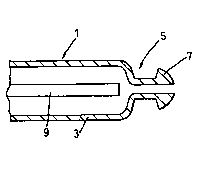Some of the information on this Web page has been provided by external sources. The Government of Canada is not responsible for the accuracy, reliability or currency of the information supplied by external sources. Users wishing to rely upon this information should consult directly with the source of the information. Content provided by external sources is not subject to official languages, privacy and accessibility requirements.
Any discrepancies in the text and image of the Claims and Abstract are due to differing posting times. Text of the Claims and Abstract are posted:
| (12) Patent Application: | (11) CA 2274501 |
|---|---|
| (54) English Title: | ASSEMBLY OF NUCLEAR FUEL RODS BUNDLE |
| (54) French Title: | ENSEMBLE DE FAISCEAUX DE BARRES DE COMBUSTIBLES NUCLEAIRES |
| Status: | Deemed Abandoned and Beyond the Period of Reinstatement - Pending Response to Notice of Disregarded Communication |
| (51) International Patent Classification (IPC): |
|
|---|---|
| (72) Inventors : |
|
| (73) Owners : |
|
| (71) Applicants : |
|
| (74) Agent: | LONG AND CAMERON |
| (74) Associate agent: | |
| (45) Issued: | |
| (86) PCT Filing Date: | 1997-12-03 |
| (87) Open to Public Inspection: | 1998-06-18 |
| Availability of licence: | N/A |
| Dedicated to the Public: | N/A |
| (25) Language of filing: | English |
| Patent Cooperation Treaty (PCT): | Yes |
|---|---|
| (86) PCT Filing Number: | PCT/GB1997/003341 |
| (87) International Publication Number: | WO 1998026425 |
| (85) National Entry: | 1999-06-04 |
| (30) Application Priority Data: | ||||||
|---|---|---|---|---|---|---|
|
A puller rod (1) is provided for use in assembling a nuclear fuel element by
loading nuclear fuel rods containing nuclear fuel pellets into a support
skeleton in the form of spaced apart grids. The puller rod (1) has a tubular
body in which at least a forward or leading portion of the body is made of
carbon fibre.
L'invention concerne une barre d'extraction (1) pour permettre l'assemblage d'un élément de combustible nucléaire en chargeant les barres de combustible nucléaires comprenant des pastilles de combustible à l'intérieur d'une structure de soutien en forme de grilles espacées. La barre d'extraction (1) possède un corps tubulaire dans lequel au moins une partie antérieure est fabriquée en fibre de carbone.
Note: Claims are shown in the official language in which they were submitted.
Note: Descriptions are shown in the official language in which they were submitted.

2024-08-01:As part of the Next Generation Patents (NGP) transition, the Canadian Patents Database (CPD) now contains a more detailed Event History, which replicates the Event Log of our new back-office solution.
Please note that "Inactive:" events refers to events no longer in use in our new back-office solution.
For a clearer understanding of the status of the application/patent presented on this page, the site Disclaimer , as well as the definitions for Patent , Event History , Maintenance Fee and Payment History should be consulted.
| Description | Date |
|---|---|
| Appointment of Agent Requirements Determined Compliant | 2020-09-02 |
| Revocation of Agent Requirements Determined Compliant | 2020-09-02 |
| Revocation of Agent Requirements Determined Compliant | 2020-09-01 |
| Appointment of Agent Requirements Determined Compliant | 2020-09-01 |
| Time Limit for Reversal Expired | 2002-12-03 |
| Application Not Reinstated by Deadline | 2002-12-03 |
| Deemed Abandoned - Failure to Respond to Maintenance Fee Notice | 2001-12-03 |
| Letter Sent | 1999-12-10 |
| Inactive: Single transfer | 1999-11-04 |
| Inactive: Cover page published | 1999-08-31 |
| Inactive: IPC assigned | 1999-08-30 |
| Inactive: First IPC assigned | 1999-08-10 |
| Inactive: Courtesy letter - Evidence | 1999-07-27 |
| Inactive: Notice - National entry - No RFE | 1999-07-21 |
| Application Received - PCT | 1999-07-16 |
| Application Published (Open to Public Inspection) | 1998-06-18 |
| Abandonment Date | Reason | Reinstatement Date |
|---|---|---|
| 2001-12-03 |
The last payment was received on 2000-11-22
Note : If the full payment has not been received on or before the date indicated, a further fee may be required which may be one of the following
Please refer to the CIPO Patent Fees web page to see all current fee amounts.
| Fee Type | Anniversary Year | Due Date | Paid Date |
|---|---|---|---|
| Basic national fee - standard | 1999-06-04 | ||
| Registration of a document | 1999-11-04 | ||
| MF (application, 2nd anniv.) - standard | 02 | 1999-12-03 | 1999-11-23 |
| MF (application, 3rd anniv.) - standard | 03 | 2000-12-04 | 2000-11-22 |
Note: Records showing the ownership history in alphabetical order.
| Current Owners on Record |
|---|
| BRITISH NUCLEAR FUELS PLC |
| Past Owners on Record |
|---|
| GRAEME MICHAEL WIGG |
| MICHAEL KEVIN BRIDGES |
| PAUL HUGH DESBOROUGH |